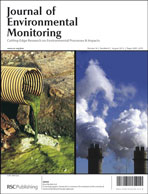Characterisation of occupational exposure to air contaminants in a nitrate fertiliser production plant
Abstract
The aim of this study was to characterise personal exposures to dust, acid vapours, and gases among workers in a Norwegian nitrate fertiliser production plant, as part of an ongoing epidemiological study. In total, 178 inhalable and 179 thoracic aerosol mass fraction samples were collected from randomly chosen workers (N = 141) from three compound fertiliser departments (A, B and C), a calcium nitrate fertiliser production department, nitric acid- and ammonia-production departments, and a shipping department. The overall median inhalable and thoracic aerosol mass concentrations were generally low (1.1 mg m−3 (min–max: <0.93–45) and 0.21 mg m−3 (min–max: <0.085–11), respectively). Workers at the compound fertiliser departments B and C had significantly higher inhalable aerosol mass air concentrations compared to the other departments (p < 0.05), except for compound fertiliser department A; however, the difference between the compound fertiliser department C and calcium nitrate department was slightly above the significant level. Workers at the compound fertiliser department A had significantly higher thoracic aerosol mass air concentrations compared to the other departments (p < 0.05), except for compound fertiliser departments B and C. The results indicate that the extrathoracic aerosol fraction of the aerosol compared to the thoracic fraction dominated in most departments. Measurement of the main constituents Ca, K, Mg, and P in the water-soluble and water-insoluble aerosol mass fractions showed that the air concentrations of these elements were low. There is, however, a shift towards more water-soluble species as the production goes from raw material with phosphate rock towards the final product of fertilisers. Overall, the arithmetic mean of water-soluble Ca in the thoracic mass fraction was 51% (min–max: 1–100). A total of 169 personal samples were analysed for HNO3 vapour and HF. The highest median concentration of HNO3 (0.63 mg m−3) was in the compound fertiliser departments B, and all measurements but four of the HF concentrations were below the LOD of 190 μg m−3. Exposures to NH3, CO and NO2 were measured using direct-reading electrochemical sensors and the time weighted overall averages were all below the LODs of the respective sensors, NH3 2 ppm; CO 2 ppm; and NO2 0.2 ppm, but some short-term peaks were detected. Even though our results indicate that the workers may experience peak exposure episodes when performing job tasks such as cleaning or maintenance work, the overall air concentrations are well below what is considered to cause known health risks.


 Please wait while we load your content...
Please wait while we load your content...